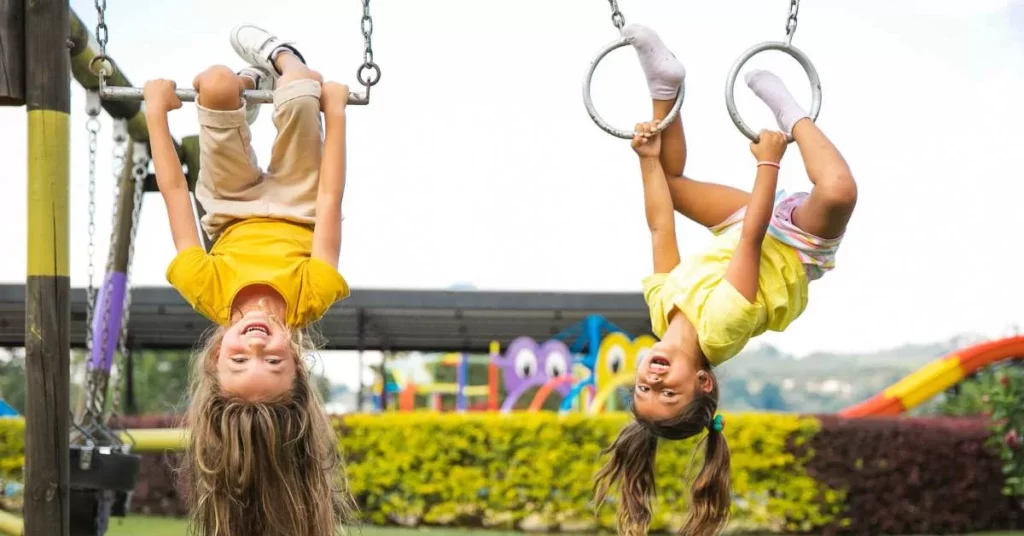First Aid for Playground Falls: Assessing Injuries and Providing Appropriate Care

Playgrounds, with their swings, slides, and climbers, offer children a haven for fun, physical activity, and social interaction. Yet, as every parent and guardian knows, with this joy and excitement comes the inherent risk of accidents.
While it’s nearly impossible to prevent every scrape or bruise—falls and accidents on the playground are, after all, a rite of passage for many kids—it’s crucial to prioritise playground safety.
Ensuring a secure environment and understanding the basics of first aid are paramount. Armed with knowledge and vigilance, caregivers can transform these spaces into areas where children can safely explore, play, and grow.
The Importance of Supervision

Active supervision on the playground isn’t just about keeping an eye out—it’s about engagement, presence, and education. Vigilant caregivers and parents, always on the alert, can quickly spot potential hazards and intervene before a child’s playful curiosity leads to a risky situation.
Their watchful eyes can deter children from straying into dangerous areas, trying out equipment beyond their age range, or engaging in unsafe play behaviors.
Supervision provides an invaluable opportunity to teach youngsters about playground etiquette and safe play.
By imparting lessons on waiting one’s turn, using equipment correctly, and being aware of others’ spaces, adults not only mitigate the risk of injuries but also instill in children the values of respect and responsibility, which they’ll carry with them beyond the playground’s boundaries.
Common Types of Playground Injuries
Even though playgrounds are filled with activity, accidents do happen occasionally. Even though these areas were created with children’s safety in mind, play is dynamic, and children sometimes suffer minor to major injuries as a result.

Cuts and Scrapes: Often caused by falls on rough surfaces or contact with sharp edges. These injuries, though mostly superficial, require cleaning to prevent infections.
Bruises: Resulting from impacts or collisions, these might appear immediately or develop over time, revealing themselves through discoloration on the skin.
Sprains and Strains: These injuries involve ligaments and muscles respectively, often occurring when a child overextends a joint or exerts a muscle excessively.
Fractures: A more severe injury where bones break or crack. Such injuries often result from hard falls or significant impacts and warrant immediate medical attention.
Head Injuries: Ranging from mild bumps to concussions, these can be the outcome of falls, especially from heights, or direct collisions. Always monitor for signs of confusion, dizziness, or vomiting post injury.
Steps to Take Immediately After a Fall
- Stay Calm: Emphasise the importance of parents remaining calm to reassure the child.
- Assess the Situation: Check the environment for potential hazards.
- Comfort the Child: Ensure the child is safe and comforted before checking for injuries.
- Check for Injuries: Conduct a systematic check from head to toe.
First-Aid for Specific Injuries

When children sustain injuries on the playground, immediate and appropriate first aid can mitigate pain, prevent complications, and accelerate healing. Knowing how to address each injury type is crucial not only for providing relief but also for ensuring the child’s long-term well-being.
Cuts and Scrapes:
- Clean the affected area gently with soap and water to remove dirt and debris.
- Apply an antibiotic ointment to prevent infections.
- Cover the wound with a bandage to keep it clean and free from irritants.
Bruises:
- Apply a cold compress or ice pack (wrapped in a cloth) to the bruised area to reduce swelling and alleviate pain.
Sprains and Strains:
- Follow the R.I.C.E. method:
- Rest: Encourage the child to refrain from using the affected limb.
- Ice: Apply an ice pack, wrapped in cloth, to minimize swelling.
- Compression: Use an elastic bandage, if available, to support the injured area.
- Elevation: Lift the affected limb above heart level to decrease swelling.
- Follow the R.I.C.E. method:
- Stabilise the injury using splints or bandages to prevent any movement.
- Avoid manipulating or realigning the broken bone.
- Seek medical attention immediately.
- Look out for signs of concussions such as dizziness, confusion, or loss of consciousness.
- If any of these symptoms are present, or if the child seems dazed or vomits, seek medical care immediately.
- Monitor the child closely for any behavioral changes, ensuring that they rest and avoid any further potential harm.
How to Prevent Injuries on Playground

Playground safety is based on preventative measures, even though it’s important to know how to react when accidents happen.
The playground equipment you choose must be suitable for the age of the kids using it; otherwise, equipment designed for older kids could be dangerous for younger ones.
Having the appropriate tools alone is insufficient, too.
Children are more likely to enjoy the play while minimising risks if they are taught how to use the equipment safely, including how to swing, slide, and climb.
The playground itself also needs to be maintained constantly. It is essential to perform regular inspections to check for wear and tear and to spot potential dangers like protruding nails or loose parts.
We can create a more secure play environment where enjoyment isn’t overshadowed by worry about getting hurt by combining awareness and education.
Our Baby First Aid course
Our baby first aid courses are available in person in your home and online.
We run classes in your home with groups of 2, 4 or up to 10 in Sydney & Melbourne and you can book in 3 easy steps!
- Pick your class
- Follow the prompts to purchase
- We will contact you within 24 hours to lock in your date of choice
Here are some other resources you may enjoy!
FREE GUIDE: Your Virtual Baby First Aid Kit
FREE GUIDE: Introducing Common Allergy Foods & Allergic Reactions
Book a baby & child first aid class
Online Baby & Child First Aid


